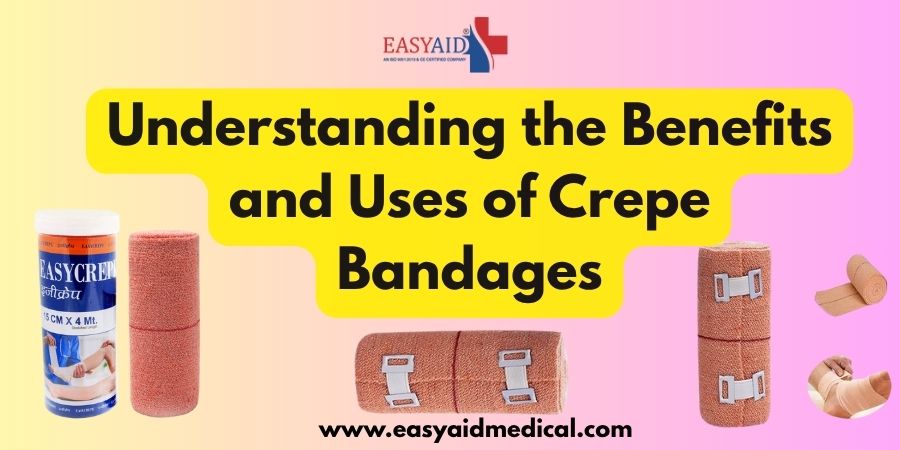Some tools are indispensable in the world of medical treatment and first aid. One of the most universal medical tools of these is the crepe bandages. This versatile and seemingly innocuous piece of cloth has some surprising breadth of application and benefit, and can be found anywhere. Out of several Easyaid Medical Products, Crepe Bandages are used in medical centers, sports kits, and home first-aid kits. With its special crinkled texture, a crepe bandage it’s specifically made to provide stability, compression and support for several medical conditions.
What is a Crepe Bandage?
A Crepe Bandage is a woven fabric bandage made predominantly of cotton, but that sometimes includes elastic fibres for enhanced healing and compression. It’s unique “crepe” texture creates an irregular, faintly crinkled surface, is created in the weaving procedures. The texture serves a functional as well as an esthetic purpose, allowing the Easyaid Crepe Bandages to conform more to the contours of the body, exert consistent pressure, and prevent slippage. They have a natural off-white color or creamish color because they are typically unbleached.
Benefits of Using Crepe Bandages:
Compression – Perhaps the single most significant benefit is Compression. These provide a compromised area even with controlled compression. By inhibiting fluid accumulation within the tissues, the compression helps in reducing the swelling. In acute injuries like sprains and strains, swelling reduction is important to control pain and encourage healing.
Support & Immobilization – A crepe bandage is beneficial in offering support to damaged joints, muscles, and ligaments, but is less rigid than a cast. It prevents further damage and allows injured tissues time to rest and recover by maintaining the damaged area in a stable position. Ankle, wrist sprains, and knee injuries are most this partial immobility.
Comfort & Conformability – Its distinctive crepe weave of the bandage allows it to conform snugly around tricky body regions like ankles, knees and elbows without folding. This ensures even pressure distribution and enhances wearer comfort, especially over a prolonged period of wear. The cotton fabrics also breathe, which reduces the risk of sweating and skin irritation.
Crepe dressings – Cotton can absorb a little perspiration or exudate, which will prevent the underlying skin from becoming macerated and reduce the likelihood of maceration if used over dressings.
Versatility & Reusability – Crepe bandages can be used on various body parts and injuries. For long-term treatment or for various incidents, good-quality crepe bandages are a cost-effective and environmentally friendly choice because they are usually washable.
Also Read – Understanding the Differences Between Nitrile, Latex, and Vinyl Gloves
Most common uses of Crepe Bandages:
Sprains and Strains – Perhaps the most common application is sprains and strains. A crepe bandage assists the patient in recovering from a sprained knee, ankle, or wrist by applying necessary compression to reduce swelling and stabilize the injured muscles or ligaments.
Muscle Pulls – As with strains, pulled calf, arm, or thigh muscles can be aided in their recovery and made less painful on movement by the mild support and compression.
Support for Fracture – A crepe bandage may be employed as an interim measure to immobilize an assumed fracture point until professional medical intervention. It reduces pain and supports the injured limb during transport.
Holding Dressings – Would dressings or splints be held firmly in position with crepe bandages? Their elasticity and conformability ensure that the dressings remain firmly in position without being uncomfortably unpleasant or constricting.
Varicose Veins and Venous Insufficiency – To control the symptoms of varicose veins or chronic venous insufficiency, physicians may sometimes recommend using crepe bandages to compress the legs. Compression reduces edema in the lower leg and enhances blood flow.
Post Surgery Compression – Crepe bandages can be utilized to provide compression, reduce post-operative edema, and offer light support to the healing site after certain surgical procedures.
Edema Management – In a medical setting, crepe bandages may also be applied to limbs with generalised swelling that is not necessarily the outcome of an acute trauma to prevent fluid accumulation.
Conclusion –The Easycrepe Cotton Crepe Bandage is a surprisingly simple but highly effective medical device. It’s a crucial first-aid element for the treatment of a range of injuries and conditions due to its ability to provide controlled compression, relaxed support and reliable immobilization. This will remain a valuable instrument for promoting recovery and healing if its benefit is understood and utilized effectively

